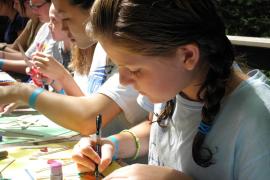In May 2024, many people were treated to spectacular displays of auroras (the Northern and Southern lights) in the night sky. The displays were part of the biggest solar storm in 20 years. Reports of auroras came from as far south as Florida. There may still be more auroras this year. Are you and your campers ready for these free, spectacular nighttime shows?
Auroras are usually visible only at high latitudes near the North or South Pole. They are caused by interactions between particles from the sun and our atmosphere. Our sun erupts many more particles into space when it is very active, with sunspots, flares, and eruptions called coronal mass ejections (CME)s. This year, our sun is at a peak of activity with frequent, sizeable sunspots, flares, and CMEs. When a CME runs into the Earth, it pushes against Earth’s magnetic field and may even breach our magnetic defenses to enter Earth’s atmosphere, energizing the nitrogen and oxygen molecules. As the excited atoms return to their normal state, they emit light, giving us beautiful auroral displays.
Auroras can appear in different shapes, colors, and intensity. Sometimes they appear as long, narrow arcs of light, often extending east to west from horizon to horizon. At other times they stretch across the night sky in bands that kink, fold, and swirl, or even ruffle like curtains. They can spread out in multi-colored rays, like vertical shafts of light that stretch far up into space.
The color of the aurora depends on which gas — oxygen or nitrogen — is being excited by the electrons, and on how excited it becomes. Oxygen emits either a greenish-yellow light (the most familiar color of the aurora) or a red light (high up in the sky). Nitrogen generally gives off a blue light. The blending of these colors can also produce purples, pinks, and white.
Use NASA and NOAA activities and resources with your campers to explore auroras:
Learn More About Auroras
Make an Aurora Bracelet
- University of Alaska Museum of the North, funded by NASA HEAT
Do NASA Science — Aurorasaurus
- Report auroras from the ground up, funded by NASA
Follow NOAA SWPC Aurora Alerts
- The public can subscribe to receive NOAA space weather alerts, warnings, and watch information at pss.swpc.noaa.gov.
Photo: The aurora paints the sky near Malad City, Utah, red, purple, and green in this May 11, 2024, image. Image Credit: NASA/Bill Dunford
Carolyn Ng is an education specialist at the NASA’s Goddard Space Flight Center with the NASA Heliophysics Education Activation Team (NASA HEAT).
The views and opinions expressed by contributors are their own and do not necessarily reflect the views of the American Camp Association or ACA employees.




